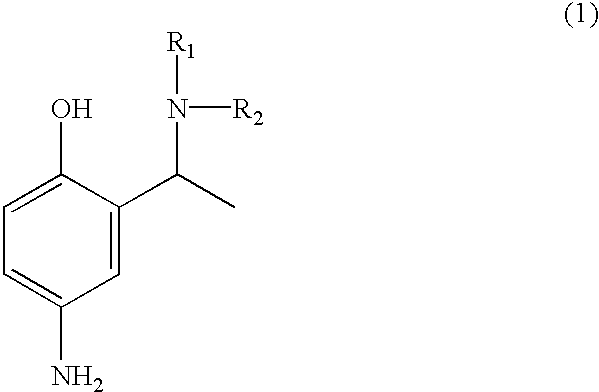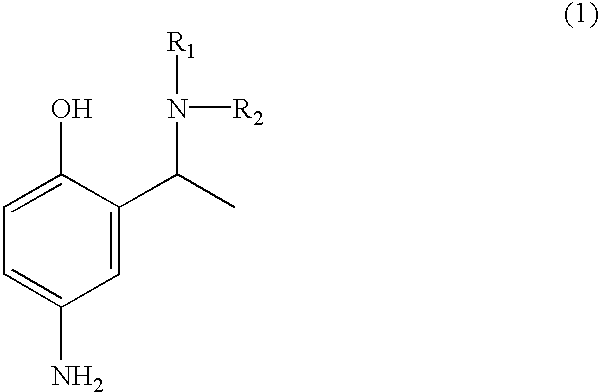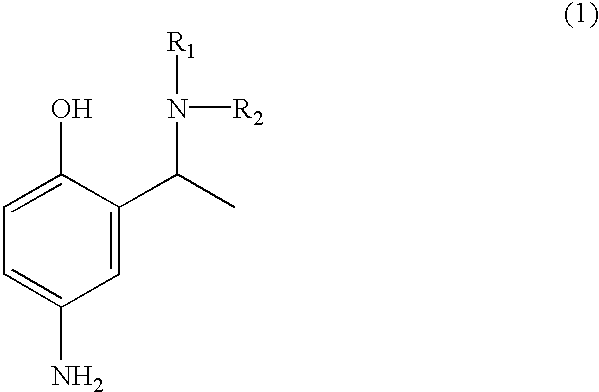Primary intermediates for oxidative coloration of hair
a technology of oxidative coloration and primary intermediates, which is applied in the direction of hair cosmetics, dyeing process, organic chemistry, etc., can solve the problems of unsatisfactory replacements of p-aminophenol, possible toxicological reasons for using p-aminophenol, etc., and achieve good dye uptake by hair, stable over a relatively long period of time, and good wash fastness
- Summary
- Abstract
- Description
- Claims
- Application Information
AI Technical Summary
Benefits of technology
Problems solved by technology
Method used
Image
Examples
synthesis examples 1 to 11
Employing the appropriate R1R2NH reagent, reducing agent and 5-butylamido-2-hydroxyacetophenone in the synthesis procedure described, the following compounds of formula (1) of this invention can be prepared:
4-amino-2-(1-phenylamino-ethyl)-phenol;
4-amino-2-(1-piperidin-1-yl-ethyl)-phenol;
4-amino-2-[1-(pyridin-3-y-amino)-ethyl]-phenol;
4-amino-2-(1-benzylamino-ethyl)-phenol;
4-amino-2-[1-(4-methoxy)-phenylamino-ethyl]-phenol;
4-amino-2-(1-amino-ethyl)-phenol;
4-amino-2-(1-dimethylamino-ethyl)-phenol;
4-amino-2-(1-morpholin-4-yl-ethyl)-phenol;
4-amino-2-[1-(4-methoxy)-benzylamino-ethyl]-phenol;
4-amino-2-(1-methylamino-ethyl)-phenol; and
4-amino-2-[1-(2-hydroxyethylamino)-ethyl]-phenol.
As used herein, the term “hair dyeing composition” (also synonymously referred to herein as the hair dye composition, the hair coloring composition, or the hair dye lotion) refers to the composition containing oxidation dyes, including the novel compounds described herein, prior to admixture with the developer c...
example 1
Dyeing Example 1
The following composition shown in Table 1 can be used for dyeing Piedmont hair. 100 g of the dyeing composition is mixed with 100 g 20 volume hydrogen peroxide. The resulting mixture is applied to the hair and permitted to remain in contact with the hair for 30 minutes. The dyed hair is then shampooed, rinsed with water and dried. The ranges of ingredients set out in Table 1 are illustrative of useful concentrations of the recited materials in a hair dye product.
TABLE 1Composition for Dyeing HairIngredientsRange (wt %)Weight (%)Cocamidopropyl betaine 0-2517.00Polyquaternium-220-7 5.00Monoethanolamine1 0-15 2.00Oleic Acid 2-22 0.75Citric Acid0-3 0.1028% Ammonium hydroxide1 0-15 5.00Behentrimonium chloride1-5 0.50Sodium sulfite0-1 0.10EDTA0-1 0.10Erythorbic acid0-1 0.40Ethoxydiglycol 1-10 3.50C11-15 Pareth-9 (Tergitol 15-S-9)0.5-5 1.00C12-15 Pareth-3 (Neodol 25-3)0.25-5 0.50Isopropanol 2-10 4.00Propylene glycol 1-12 2.00p-phenylenediamine0-51 mmoleN,N-Bis(hydroxye...
PUM
| Property | Measurement | Unit |
|---|---|---|
| color | aaaaa | aaaaa |
| color shades | aaaaa | aaaaa |
Abstract
Description
Claims
Application Information
 Login to View More
Login to View More - R&D
- Intellectual Property
- Life Sciences
- Materials
- Tech Scout
- Unparalleled Data Quality
- Higher Quality Content
- 60% Fewer Hallucinations
Browse by: Latest US Patents, China's latest patents, Technical Efficacy Thesaurus, Application Domain, Technology Topic, Popular Technical Reports.
© 2025 PatSnap. All rights reserved.Legal|Privacy policy|Modern Slavery Act Transparency Statement|Sitemap|About US| Contact US: help@patsnap.com



